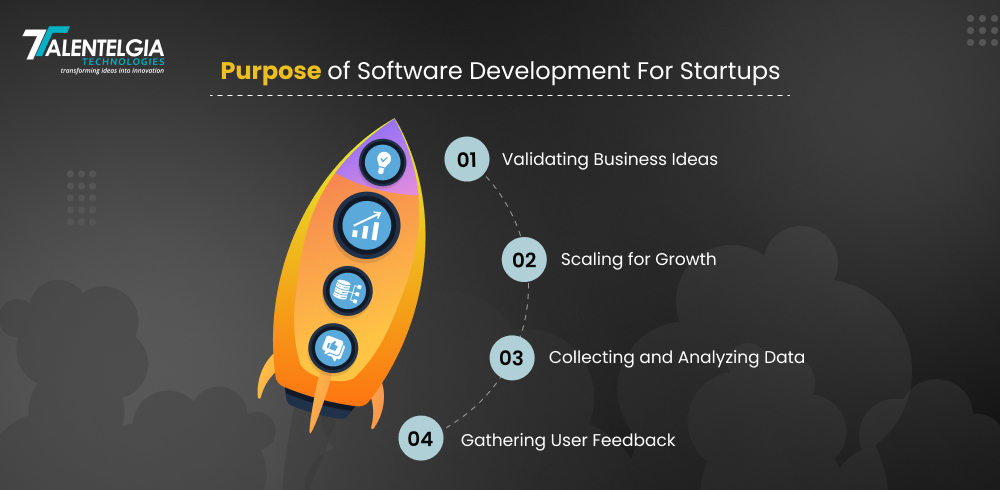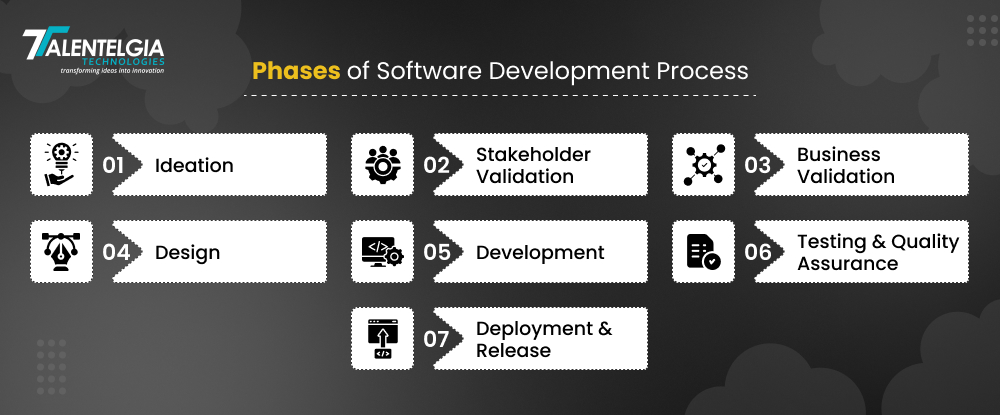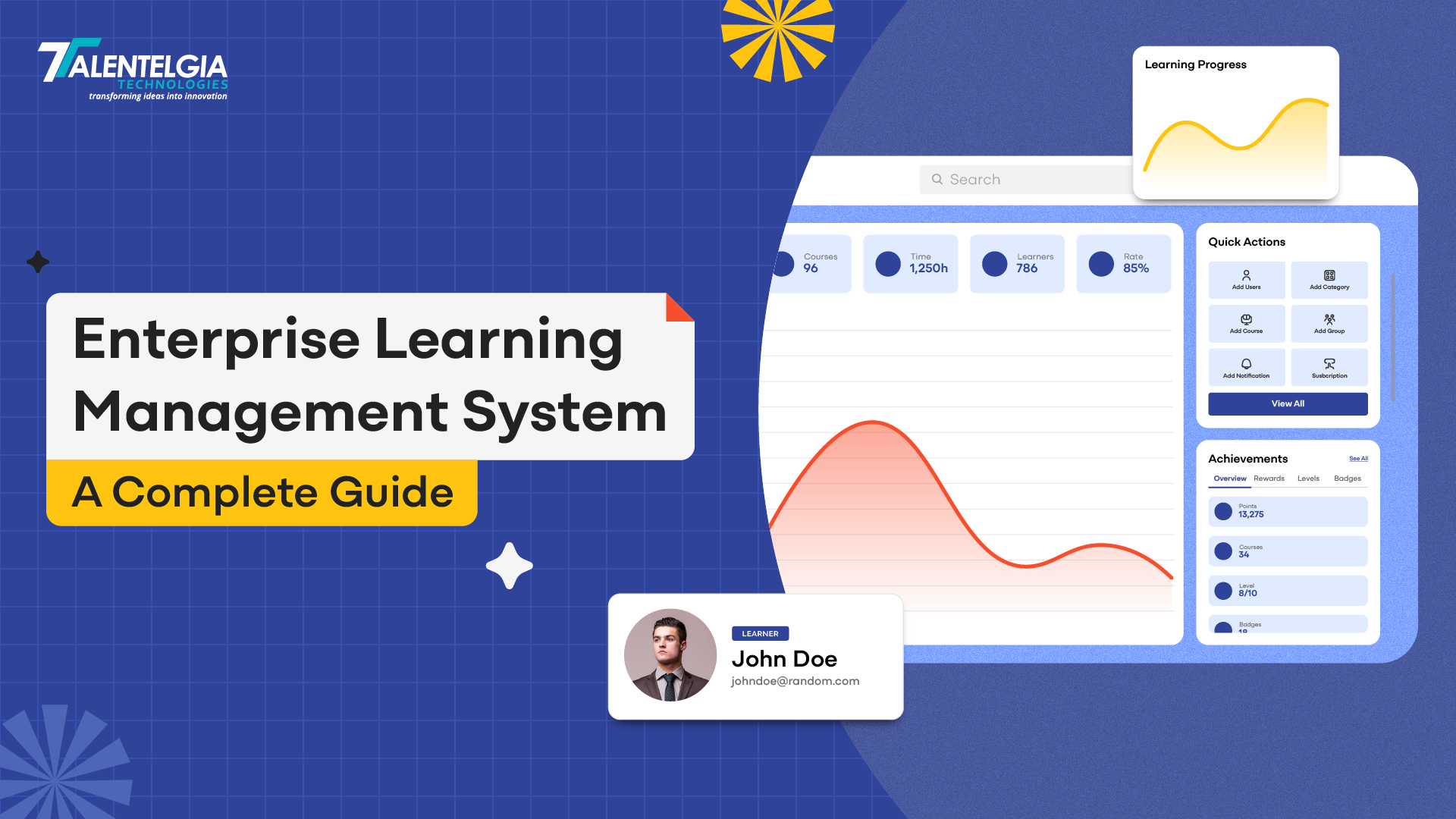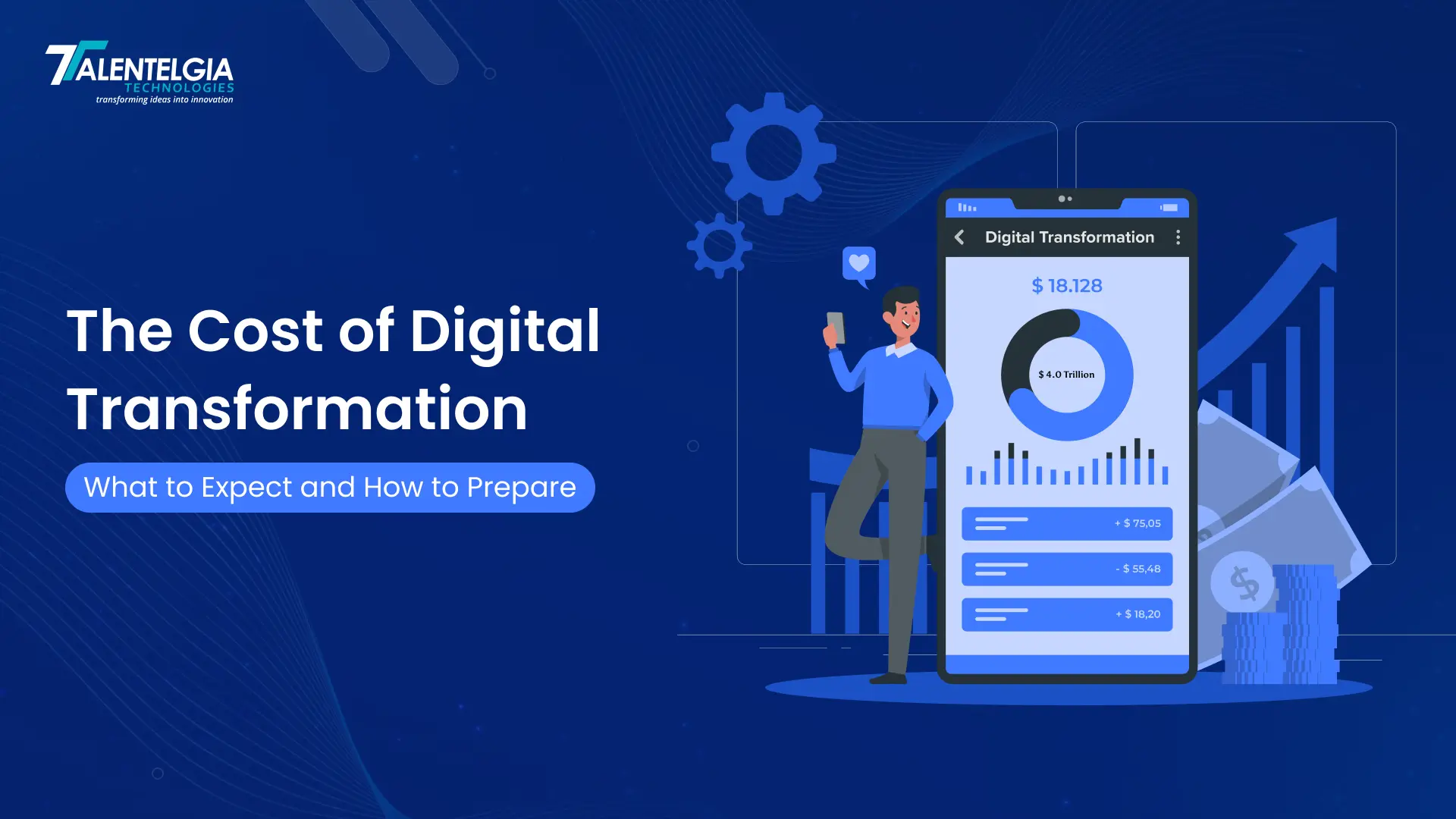Wondering what makes a startup stand out in the first year of setup? It’s not just the idea. It’s the strategic planning and long-term thinking that makes it stand out. Most importantly, startups that thrive in the first year and in the long term leverage technology to its full potential. By automating workflows and creating a seamless user experience, successful businesses utilize software development for startups effectively.
But how do you leverage technology effectively? It’s simple, you develop an effective software that will lay the foundation for your business. You must also remember to align it as per your business requirements. While both these factors will give you a competitive edge, understanding them deeply will make the process seamless.
In this blog, we will help you understand the software development process better. We will also be covering how you can leverage it to your advantage.
But, before getting started, if you are already in the business or just getting started, Talentelgia can help you with software development for startups. This way, all you will have to do is connect with us and share your requirements. Rest everything will be effectively taken care of.
Purpose of Software Development For Startups
Software development plays a crucial role in the long-term success of startups. It offers tools and processes that enhance overall efficiency and give deeper insights into what needs to be updated. Moreover, it enables entrepreneurs to craft customized solutions as per market gap while optimizing resources. Here’s how software development helps startups.

Validating Business Ideas
For startups, the aim is to validate their business ideas as quickly and cheaply as possible. A startup does not need to launch a fully featured product; instead, it can focus on developing a Minimum Viable Product (MVP)—a simplified version of the software containing only the most essential features.
For example, if you want to launch a peer-to-peer (P2P) payment application in the US, your MVP may enable users to send money based solely on phone numbers. You can present this MVP to the selected target group and then use their comments. Then, you can decide on further development and enhancement of the product.
Scaling for Growth
Once your software gains traction, scaling becomes a priority. Hosting applications on cloud platforms enables startups to seamlessly increase computing resources to match growing demand. For example, a growing e-commerce platform might need to handle spikes in user traffic during holiday sales. The cloud allows for effortless scaling without hefty upfront infrastructure investments. Additionally, expanding into new regions becomes more manageable with cloud-based solutions. If hiring in-house becomes challenging, outsourcing development to skilled IT specialists ensures you meet scaling demands efficiently.
Collecting and Analyzing Data
Successful startups are founded on data-driven decisions. Through building software with analytics capabilities, the business can collect and process information to make informed choices. For example, a fitness app could track user behavior, such as exercise frequency and favorite workout types, sending this data to servers for detailed analysis. This insight helps startups identify trends, assess user preferences, and optimize the product to enhance user engagement.
Gathering User Feedback
Continuous user feedback is essential for startups to refine their products and remain competitive. The software provides an effective channel for collecting user opinions. For example, integrating an AI-driven chatbot in a customer service app allows startups to address common inquiries while simultaneously collecting feedback. This feedback can be directed to support teams to identify pain points and improve the product, ensuring it continues to meet user expectations.
Phases of Software Development Process For Startups

Developments for new products require a structured process from idea to launch to make sure everything goes smoothly. It is up to you to determine what steps are needed to fulfill the goals or deadlines.
The following are the most important phases of the software development life cycle (SDLC):
1. Ideation
Software development for startups starts with the initiation of a new idea. Ideation usually involves extensive brainstorming about the plans and procedures to be followed.
A major aspect of this phase is, ‘no idea should be dismissed.’ It is important to document all suggestions and compile them into an idea bank. After this, you can evaluate and refine the ideas as per your understanding.
You might be wondering how to undertake ideation properly. Well, a good way to start with is market research. This will give you insights into your competitors as well as industry standards. You can also do a SWOT analysis to refine and choose the best approach for your startup.
2. Stakeholder Validation
Once you have a clear concept, you can validate it with your partners, investors, and other stakeholders. This will need a clear product or service concept including your business plan, competitor analysis, and budget.
You might also need to prepare a minimum viable product (MVP) that demonstrates the core features of your solution.
3. Business Validation
After having a concept, validate it with partners, investors, and stakeholders. It involves having a clear product concept, including your business plan, an analysis of direct and indirect competitors, and monetization strategies During this phase, you may also have to design an MVP that showcases the essential features and functionalities of your solution.
Some startups develop the MVP during the design phase after validating the business plan. However, in the case of government funding or angel investors, an MVP may be essential to present your idea as viable.
4. Design
While developing a product, the design team creates a software portrait to help developers visualize the final product. This is a stage where finalized ideas blend with the business plan and form a tangible, real product. As noted above, your startup can produce the MVP in this stage.
For instance, when it comes to a fitness app, the design team would draw user screens for logging workouts, and goal-setting. They would also keep in mind a progress tracker while designing the product.
5. Development
The development stage forms the core of any software development process for startups. However, before starting the process, the development team must agree on the tech stack first.
For instance, while developing a cross-platform app, your developers need to choose between frameworks like Flutter or react native. Once the tech stack is decided, the team can start building the product.
6. Testing and Quality Assurance
Testing and quality assurance is the most important part of software development for startups. In this phase, QA testers and engineers validate the software as per set standards. It is then followed up by performance testing, security, and overall functionality. The motive behind this is to identify and resolve any usability issues so that the software meets the highest standards.
7. Deployment and Release
Once the testing and deployment phase is done, the software becomes ready for its final release. Now, before releasing the final product, you must create a deployment strategy. A good way to do this would be factoring in infrastructure requirements, security, and scalability. Developers usually rely on DevOps practices and cloud-based platforms to enhance scalability and simplify the deployment process.
Software Development Cost For Startups
Developer time is the biggest cost in software development for startups. An in-house team costs a fixed salary, benefits, and workspace expenses. Hiring, training, and equipment further add to the cost.
Startups can hire freelancers to avoid long-term commitments. However, freelancers are hard to manage and lead. It is challenging to find skilled freelancers that will match the needs of your project.
Developer rates vary by location. It costs around $8,504 per month in the US to hire a developer. It is important to note that many startups outsource to offshore firms, saving them money. Ukrainian developers, for instance, have quality at reduced rates. Read More: Software Development Cost
Let’s compare the cost of building a simple software by in-house hiring versus hiring mid-level developers.
| Feature | Hours | Cost (US) @ $140/hr | Cost (Ukraine) @ $56/hr |
| Tutorial Screens | 30 | $4,200 | $1,680 |
| Sign In | 80 | $11,200 | $4,480 |
| Home Page | 200 | $28,000 | $11,200 |
| Photo/Video | 60 | $8,400 | $3,360 |
| User Profile | 70 | $9,800 | $3,920 |
| Search | 60 | $8,400 | $3,360 |
| Chat | 90 | $12,600 | $5,040 |
| Notifications | 40 | $5,600 | $2,240 |
| Total | $88,200 | $35,280 |
Conclusion
Software development for startups is not just writing code but a solid foundation that propels your startup forward. Smart, scalable solutions, combined with software aligned with your business goals, give your startup the tools to thrive in a competitive market. In-house development, freelancers, or offshore teams are some of the approaches that could save costs and accelerate time to market.
Remember, the first year is critical for any startup. Leverage technology to build, test, and refine your ideas. With strategic planning, quality software, and a clear vision, you can transform innovative concepts into sustainable, successful businesses.
If you are ready to take the next step, Talentelgia is here to help turn your vision into reality. Let's build the future-one line of code at a time.


 Healthcare App Development Services
Healthcare App Development Services
 Real Estate Web Development Services
Real Estate Web Development Services
 E-Commerce App Development Services
E-Commerce App Development Services E-Commerce Web Development Services
E-Commerce Web Development Services Blockchain E-commerce Development Company
Blockchain E-commerce Development Company
 Fintech App Development Services
Fintech App Development Services Fintech Web Development
Fintech Web Development Blockchain Fintech Development Company
Blockchain Fintech Development Company
 E-Learning App Development Services
E-Learning App Development Services
 Restaurant App Development Company
Restaurant App Development Company
 Mobile Game Development Company
Mobile Game Development Company
 Travel App Development Company
Travel App Development Company
 Automotive Web Design
Automotive Web Design
 AI Traffic Management System
AI Traffic Management System
 AI Inventory Management Software
AI Inventory Management Software
 AI Software Development
AI Software Development  AI Development Company
AI Development Company  AI App Development Services
AI App Development Services  ChatGPT integration services
ChatGPT integration services  AI Integration Services
AI Integration Services  Generative AI Development Services
Generative AI Development Services  Natural Language Processing Company
Natural Language Processing Company Machine Learning Development
Machine Learning Development  Machine learning consulting services
Machine learning consulting services  Blockchain Development
Blockchain Development  Blockchain Software Development
Blockchain Software Development  Smart Contract Development Company
Smart Contract Development Company  NFT Marketplace Development Services
NFT Marketplace Development Services  Asset Tokenization Company
Asset Tokenization Company DeFi Wallet Development Company
DeFi Wallet Development Company Mobile App Development
Mobile App Development  IOS App Development
IOS App Development  Android App Development
Android App Development  Cross-Platform App Development
Cross-Platform App Development  Augmented Reality (AR) App Development
Augmented Reality (AR) App Development  Virtual Reality (VR) App Development
Virtual Reality (VR) App Development  Web App Development
Web App Development  SaaS App Development
SaaS App Development Flutter
Flutter  React Native
React Native  Swift (IOS)
Swift (IOS)  Kotlin (Android)
Kotlin (Android)  Mean Stack Development
Mean Stack Development  AngularJS Development
AngularJS Development  MongoDB Development
MongoDB Development  Nodejs Development
Nodejs Development  Database Development
Database Development Ruby on Rails Development
Ruby on Rails Development Expressjs Development
Expressjs Development  Full Stack Development
Full Stack Development  Web Development Services
Web Development Services  Laravel Development
Laravel Development  LAMP Development
LAMP Development  Custom PHP Development
Custom PHP Development  .Net Development
.Net Development  User Experience Design Services
User Experience Design Services  User Interface Design Services
User Interface Design Services  Automated Testing
Automated Testing  Manual Testing
Manual Testing  Digital Marketing Services
Digital Marketing Services 
 Ride-Sharing And Taxi Services
Ride-Sharing And Taxi Services Food Delivery Services
Food Delivery Services Grocery Delivery Services
Grocery Delivery Services Transportation And Logistics
Transportation And Logistics Car Wash App
Car Wash App Home Services App
Home Services App ERP Development Services
ERP Development Services CMS Development Services
CMS Development Services LMS Development
LMS Development CRM Development
CRM Development DevOps Development Services
DevOps Development Services AI Business Solutions
AI Business Solutions AI Cloud Solutions
AI Cloud Solutions AI Chatbot Development
AI Chatbot Development API Development
API Development Blockchain Product Development
Blockchain Product Development Cryptocurrency Wallet Development
Cryptocurrency Wallet Development About Talentelgia
About Talentelgia  Our Team
Our Team  Our Culture
Our Culture 
 Healthcare App Development Services
Healthcare App Development Services Real Estate Web Development Services
Real Estate Web Development Services E-Commerce App Development Services
E-Commerce App Development Services E-Commerce Web Development Services
E-Commerce Web Development Services Blockchain E-commerce
Development Company
Blockchain E-commerce
Development Company Fintech App Development Services
Fintech App Development Services Finance Web Development
Finance Web Development Blockchain Fintech
Development Company
Blockchain Fintech
Development Company E-Learning App Development Services
E-Learning App Development Services Restaurant App Development Company
Restaurant App Development Company Mobile Game Development Company
Mobile Game Development Company Travel App Development Company
Travel App Development Company Automotive Web Design
Automotive Web Design AI Traffic Management System
AI Traffic Management System AI Inventory Management Software
AI Inventory Management Software AI Software Development
AI Software Development AI Development Company
AI Development Company ChatGPT integration services
ChatGPT integration services AI Integration Services
AI Integration Services Machine Learning Development
Machine Learning Development Machine learning consulting services
Machine learning consulting services Blockchain Development
Blockchain Development Blockchain Software Development
Blockchain Software Development Smart contract development company
Smart contract development company NFT marketplace development services
NFT marketplace development services IOS App Development
IOS App Development Android App Development
Android App Development Cross-Platform App Development
Cross-Platform App Development Augmented Reality (AR) App
Development
Augmented Reality (AR) App
Development Virtual Reality (VR) App Development
Virtual Reality (VR) App Development Web App Development
Web App Development Flutter
Flutter React
Native
React
Native Swift
(IOS)
Swift
(IOS) Kotlin (Android)
Kotlin (Android) MEAN Stack Development
MEAN Stack Development AngularJS Development
AngularJS Development MongoDB Development
MongoDB Development Nodejs Development
Nodejs Development Database development services
Database development services Ruby on Rails Development services
Ruby on Rails Development services Expressjs Development
Expressjs Development Full Stack Development
Full Stack Development Web Development Services
Web Development Services Laravel Development
Laravel Development LAMP
Development
LAMP
Development Custom PHP Development
Custom PHP Development User Experience Design Services
User Experience Design Services User Interface Design Services
User Interface Design Services Automated Testing
Automated Testing Manual
Testing
Manual
Testing About Talentelgia
About Talentelgia Our Team
Our Team Our Culture
Our Culture

















 Write us on:
Write us on:  Business queries:
Business queries:  HR:
HR: 




